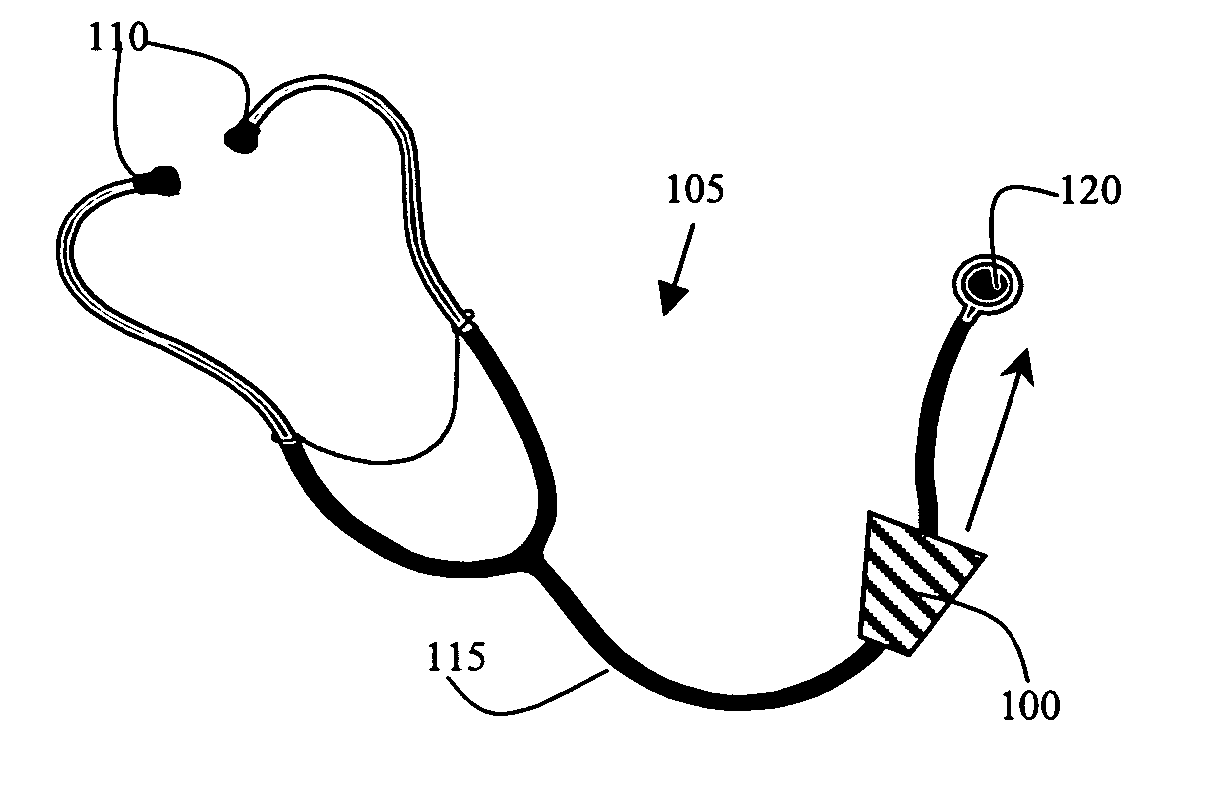Wearable stethoscope sanitizing device
a stethoscope and sanitizing technology, applied in the field of sanitizing devices, can solve the problems of troublesome, worsening danger, and often forgotten stethoscope cleaning practice among medical personnel, and achieve the effect of cleaning both the bell and the diaphragm surfa
- Summary
- Abstract
- Description
- Claims
- Application Information
AI Technical Summary
Benefits of technology
Problems solved by technology
Method used
Image
Examples
embodiment 100
[0026]FIG. 1(a) shows the preferred embodiment 100 slide-ably attached to the sound conveying tube 115 of a stethoscope 105. During the normal use of the stethoscope 105, a nurse or doctor presses the diaphragm or the bell in the head 120 against various areas on a patient's body and listens, via ear-pieces 110, to the sounds of the patient's body. The preferred embodiment 100 is a flexible cone shaped pocket that uses foam pads to store a sanitizing agent, such as alcohol gel, in its interior. The cone shaped pocket has a large opening at one end that allows for entry of the head 120, and a small opening at the opposite end that allows the present sanitizing device 100 to be slid along tube 115. After the nurse or doctor is finished using the stethoscope 105, the sanitizing device 100 is slid down the length of tube 115 until it completely covers the head 120, as is shown in FIG. 1(b).
[0027]FIG. 1(b) shows the preferred embodiment 100 in operational position, covering the head port...
embodiment 400
[0033]FIG. 4 shows an alternative embodiment 400 of the present sanitizing device. This embodiment 400 works in the same manner as the preferred embodiment wherein the head of the stethoscope enters and exits the sanitizing device 400 via a large opening 425 in the bottom of the device, and the small opening 430 at the top of the device is adapted to slide along the tube of stethoscope. The alternative embodiment 400 differs from the preferred embodiment by incorporating a reversible feature to the device, which allows the same sanitizing device to be used with both adult sized and pediatric sized stethoscopes. The back panel 415 of the device 400 is made of a rigid, or semi-rigid, material that allows both sides of the panel 415 to be selectively used to hold a sanitizing foam pad. The front panel 405 is attached to one side of the back panel 415 via a hinge 410 that allows the front panel 405 to swing so that the front panel can be used to cover either the front or the back side o...
embodiment 1000
[0039]FIG. 10 is a perspective view of a third alternative embodiment 1000 of the present stethoscope sanitizing device. This embodiment 1000 is designed to fit into the front pocket of a health care provider's shirt or lab coat, and takes advantage of the carry method used by many doctors and nurses, wherein the stethoscope is slung around the person's neck. When in its operational position, this embodiment 1000 provides sanitation of the diaphragm and bell by simply sticking the head portion of the stethoscope into the person's front pocket. The sanitizing device 1000 can be made of a single sheet of material that has a similar width as a traditional front pocket and has a length that is approximately twice as long as the front pocket. The material is folded substantially in half so that it obtains the size of the front pocket, and front and back panels are created. Of course, the device 1000 can also be created by attaching the bottoms of two different sheets of material. In eith...
PUM
 Login to View More
Login to View More Abstract
Description
Claims
Application Information
 Login to View More
Login to View More - R&D
- Intellectual Property
- Life Sciences
- Materials
- Tech Scout
- Unparalleled Data Quality
- Higher Quality Content
- 60% Fewer Hallucinations
Browse by: Latest US Patents, China's latest patents, Technical Efficacy Thesaurus, Application Domain, Technology Topic, Popular Technical Reports.
© 2025 PatSnap. All rights reserved.Legal|Privacy policy|Modern Slavery Act Transparency Statement|Sitemap|About US| Contact US: help@patsnap.com



